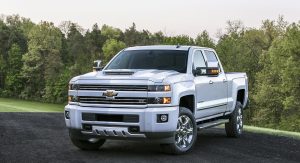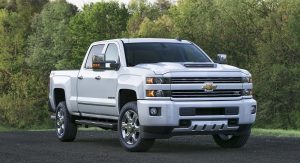Chevrolet’s all-new patented air intake system will drive cool, dry air into the the truck’s Duramax diesel unit for sustained performance and cooler temperatures during difficult conditions.
Aesthetically speaking, the change is marked by a large functional hood scoop which in turn helps the engine receive about 60% of its air during running. According to Chevy, this way, the air is very close to the outside ambient temperature and a lot cooler than if sourced from underneath the hood – which in turn allows the Duramax diesel to maintain full power and speed even when pulling a trailer or any other heavy object.
Also, at highway speed, a ram-air effect helps pack more air into the engine, while the filter draws 40% more air from a dry location in one of the front fenders, which then blends with the cooler air from the hood inlet before funneling into the diesel unit’s combustion chambers.
“The 2017 Silverado HD was engineered to provide maximum utility for our customers in even the most extreme situations,” said Eric Stanczak, chief engineer. “While developing this all-new induction system, we considered our customers towing a maximum-weight trailer through the Eisenhower Tunnel on a hot, rainy summer day.”
The Eisenhower Tunnel happens to be the highest vehicle tunnel in the world at more than 11,000 feet (3,352 m) above sea level.
Apparently, in order to get the most out of your engine in terms of performance, you need more than just cool air – you need it to be clean and dry. This is why the 2017 Silverado HD‘s functional hood scoop uses a unique air/water separator that ensures only combustion-friendly dry air is drawn into the engine. After entering the expansion chamber, the air charge does a sharp, 180-degree turn on its way to the filter housing, creating a velocity change that builds heavy droplets out of humidity or mist. The larger droplets are then flung centrifugally against the outside wall of the housing, while the collected water drains through a valve.
Chevrolet tested the effectiveness of the system by gathering real-world data on misty rains to monsoon-level downpours, but also from light snow conditions to wind-driven ice pellets or desert dust to arctic cold.





